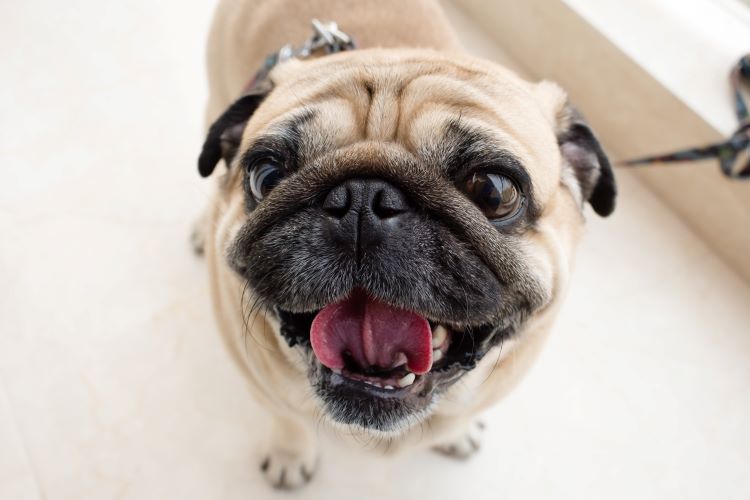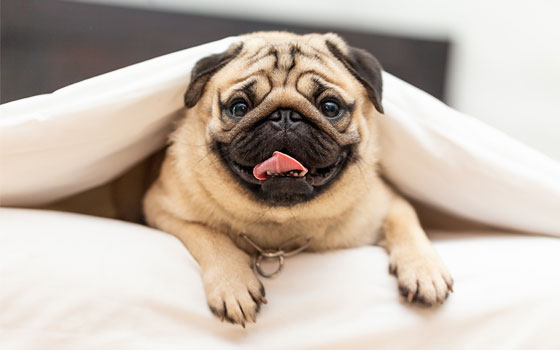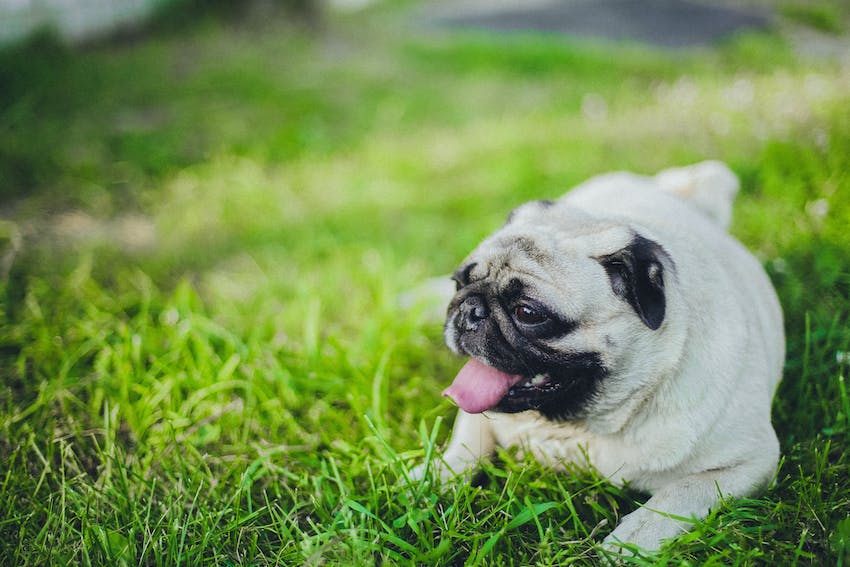Ready to help treat your pet to a healthy life?
Pugs: A Dog Breed Guide
By : Trupanion Staff | Updated Mar 5, 2024

Ah, the Pug. Small but mighty, this endlessly charismatic pup is popular around the world thanks to its charm and distinctive appearance. But while it's easy to fall for these pups, they come with potentially serious health risks and require attentive pet ownership. If you're considering adopting a Pug, want to learn more about your current pet, or are simply curious about the breed, arming yourself with knowledge is the first step. With proper care and attention, Pugs make wonderful pets for families and individuals alike, bringing joy and companionship to their owners' lives.
Pug fun facts
- “Multum in parvo,” a Latin phrase meaning “much in little” is referenced in the American Kennel Club’s breed standard for the Pug. It’s a perfect description of the Pug’s temperament — a lot of charm and personality in a small body!
- Truly an ancient breed, the Pug is believed to have been around since at least 400 B.C., and were kept as pets of Buddhist monks in Tibet.
- Pug noises are out of this world — a Pug named Gyoza provided the alien-like sounds for the video game ‘Halo Infinite.’
- Put a group of these dogs together and you’ve got what’s called a “grumble” of Pugs.
- Where did the Pug get its unique name? Most likely related to their wrinkly flat face, one theory suggests the name Pug comes from the Latin word “pugnus,” which means “fist.” If you don’t think their face resembles a closed fist, another theory traces the name back to the Marmoset monkeys kept as pets in the 1700s. These monkeys were also referred to as Pugs, who shared similar features and expressions.
- Pugs have a long history of royal positions. Companions of ancient Chinese emperors, they were also the official breed of the Dutch House of Orange. Napoleon's wife, Josephine, owned a Pug named Fortune, and Queen Victoria of England was a prolific breeder of Pugs.
- When the Roman Catholic Church banned its followers from joining the Freemasons in the mid-1700s, a secret pre-Masonic group called the Order of the Pug was formed in Germany. The breed was chosen as their mascot because it was loyal and trustworthy. New members were rumored to be initiated into the group by having to wear a dog collar and scratch at the door for entry. They were then paraded around blindfolded while the other members barked loudly at them.
- Pugs live an average of 12 to 15 years. Nevertheless, a Pug named Snookie once lived for an astounding 27 years and 284 days!
History of the Pug
Pugs have a long, rich history. They can be traced back to 400 B.C., living as a pet of Tibetan Buddhist monks. The Chinese developed a few different dog breeds to act as companions and guard dogs of royalty, and the Pug excelled in this role. A favorite dog of the Song Dynasty in the late 1st century and early 2nd century, Pugs remained a treasure found exclusively in Asia until the 16th century. These flat-faced dogs were known as Lo-sze.
Introduced to Europe by Dutch traders in the 1500s, they became quite popular with royal houses. Reportedly, a Pug named Pompey saved the life of Willam I, the Prince of Orange, when he barked to alert him of approaching assassins. This act led to the breed being adopted as the official mascot of the House of Orange. You can see a Pug resting at the feet of William’s statue in the city of Delft.
The Pug made its way to England with William III and Mary II in 1688, and the breed continued to thrive. Pugs spread throughout Europe and were often referred to as the Dutch Mastiff. Even Josephine Bonaparte, Napoleon's wife, was the owner of a Pug named Fortune.
Pugs truly exploded in popularity during the 1800s, due to the breed being a favorite of Queen Victoria, who bred many of her own. Crossing the pond to the United States, Pugs wriggled their way into the homes and hearts of Americans quite quickly. The American Kennel Club officially recognized the breed in 1885. Only one Pug has ever won Best in Show at Westminster — a Pug named Dhandys Favorite Woodchuck took the top spot in 1981.
Breed changes over time
The Pug breed helped in the development of more modern dog breeds, such as the Cavalier King Charles Spaniel and French Bulldog. Most recently, the Pug was crossed with the Beagle to create a popular designer breed called the Puggle.
This breed has gone through some notable and detrimental physical changes over time. Pugs depicted in paintings and sculptures before the late 1800s show a breed with a much more pronounced muzzle and longer legs. It wasn’t until an infusion of Pugs imported from China in the 1860s that the shorter legs and flatter face became the norm. This period was also when black colored Pugs became fashionable, thanks to Lady Brassey of England bringing black Pugs back home with her from China in 1886.

Getting to know the Pug
What do Pugs look like?
Fans of the breed adore the Pug's wrinkled face, big eyes, and curled tail. Fully grown, Pugs weigh between 14 and 18 lbs. and stand 10 to 13 inches tall. Their legs are quite petite, while their bodies are dense and rounded — even healthy Pugs are little chonkers!
A quick list of the breed's physical traits include:
- Brachycephalic (flat-face and broad skull)
- Big round eyes
- Curled tail (often with a double curl)
- Wrinkled face and wrinkles along on their back
Puggy personality
Pugs are known for their affectionate and sociable nature. While there are always exceptions within every dog breed, the average Pug knows how to prioritize — their people and food are their favorite things! Entertaining and fun-loving, this breed knows how to put on the charm. Their expressive features will attract lots of attention, and they will do anything for treats. Pugs take their job of companionship seriously and want to be close to their people. If you love snuggling up with a snorting, snuffling, and snoring (and often gassy) pup, a Pug is a dog for you.
Similar dog breeds
- French Bulldog
- Boston Terrier
- Shih Tzu
- Pekingese
- Japanese Chin
Pug Behavior and Training
Specifically bred to be a companion, Pugs are eager to please and a joy to train. This breed is very playful, so making training fun and playing games will build a positive relationship between you and your Pug. They’re very food motivated, so care must be taken to not overfeed during training as pugs can quickly become overweight.
Trainer tip
Use portions of your Pug’s daily food ration as training rewards, or cut down their regular food intake to balance their training treat intake.
Many people describe Pugs as being a “stubborn” breed and hard to train. It all comes down to knowing what motivates them and using that to your advantage. Pugs are an inquisitive and confident breed, meaning they might want to explore or chase after a squirrel more than they want to listen to you. With positive reinforcement training methods and consistency, a Pug can be a well-trained member of your family.
Pugs can also be sensitive to harsh scolding or yelling. Punishments, whether verbal or physical, not only damage the relationship between a Pug and their owner but also tend not to work in the long run. Often, it creates long-term behavioral issues. Train your Pug puppy from a young age, and focus on teaching them what to do to set them up for a lifetime of success.
Do Pugs get along with others?
Pugs are a social breed and attract lots of attention from passers-by. It’s essential to give them proper proactive exposure to new sights, sounds, people, dogs, and other animals as a young puppy to set them up for successful social interactions.
Pair meeting new people or animals with high-value training treats or a favorite toy, and keep introductions short and sweet so it doesn’t get overwhelming.
This breed is a favorite choice for families with children, as they are quite sturdy for a small dog and playful. Make sure to socialize your Pug as a puppy, with children of all ages, to build their social skills. Young children and dogs should always be supervised, and it’s helpful for a dog to have their own “safe space” where they can go when they need some quiet time.
If a Pug has been properly socialized since puppyhood, they do quite well with other dogs and animals in the home. Their playstyle can be rough-and-tumble, so playtime should be supervised to make sure playmates don’t get overwhelmed and everyone is having a good time.
Exercise requirements
Though known for being leisurely, Pugs are still an active dog breed that needs daily exercise. Their love of food means it’s important to keep them at a healthy weight. Due to their flat-faces and breathing difficulties, it’s essential to make sure they don’t overdo it. A little outside playtime or short walks are a great way to keep a Pug healthy.
Never exercise your Pug in warmer temperatures or when it’s humid outside, and provide lots of breaks and water. They should always be monitored for heatstroke symptoms, which include: rapid panting, drooling, bright red tongue or gums, and trouble breathing.
Mental enrichment needs
Pugs need mental enrichment, not only to stay entertained but also to help prevent separation anxiety. Teach your Pug new tricks, attend obedience classes, join a dog sport, and provide dog puzzles and interactive toys. Feeding our Pug’s regular meals from a food puzzle helps to burn energy and prevents them from inhaling their food too fast. Pug puppies benefit greatly from these enrichment activities, and it helps to prevent unwanted puppy chewing and other behaviors.
Common behavioral issues
Since Pugs were bred specifically as companion dogs, they are prone to separation anxiety and isolation distress. They can be taught as a puppy that being away from their human is nothing to worry about. Spending some time on this potential problem early on will save you and your Pug many anxious days. Some Pug owners will get a second Pug to keep the first company. This doesn’t always work to help with separation anxiety, but can help with isolation distress.
Activities pugs enjoy
Pugs do well in many different activities:
- Therapy Dog Work
- Rally Obedience
- Trick Training
- Conformation (dog shows)
- Small Dog Agility
Pug health concerns
Pugs are a Brachycephalic dog breed. Due to many years of selective breeding, their airways are shortened and can cause breathing difficulties. While those short snouts can be cute, it's important to talk with your pet's veterinarian early on about any breathing concerns and risks.
If a Pug has narrowed nostrils, a component of Brachycephalic Airway Syndrome (BAS), some pet owners will elect to have a surgical procedure done to widen the nostrils (and correct other potential anatomical abnormalities of BAS). Though often not a cure, this procedure can help improve a dog’s ability to breathe.
According to Trupanion claims data, common health conditions for pugs include (but are not limited to) the following:
- Brachycephalic airway syndrome
- Hypothyroidism
- Syncope
- Hydrocephalus
- Hanging tongue
- Hip dysplasia
- Patella luxation
- Progressive retinal atrophy
Grooming and care
Pugs have a short, dense, and soft coat. The breed comes in only two colors: fawn (a cream body with a black mask and ears) and black. Black Pugs have a single layer coat, while fawn Pugs can have either a single coat or a double coat. No matter what type of coat a Pug has, they are known to be quite the shedders!
Trainer tip
Introduce your Pug puppy to the grooming experience from a young age to create a positive association that will make lifelong grooming easy.
Weekly brushing will help keep a Pug’s skin and coat healthy and manage their shedding. Regular bathing is recommended for this breed as well, with special care to keep their face wrinkles clean and dry, to keep the yeast and bacterial populations in check, and prevent uncomfortable and recurrent infections.

Pugs in pop culture
Chances are you've seen more than a few pugs in media over the years.
Famous Pug owners
- Rob Zombie (Singer/Director)
- Jessica Alba (Actress)
- Hugh Laurie (Actor)
- Gerard Butler (Actor)
- Ted Danson & Mary Steenburgen (Actors)
- Queen Victoria (Royalty)
- Dennis Quaid (Actor)
- Anna Faris (Actress)
- James Taylor (Singer)
- Billy Joel (Singer)
- Pugs in books, movies, and TV
Pugs in books, movies, and TV
- Percy from Pocahontas
- Otis from The Adventures of Milo and Otis
- Frank from Men in Black
